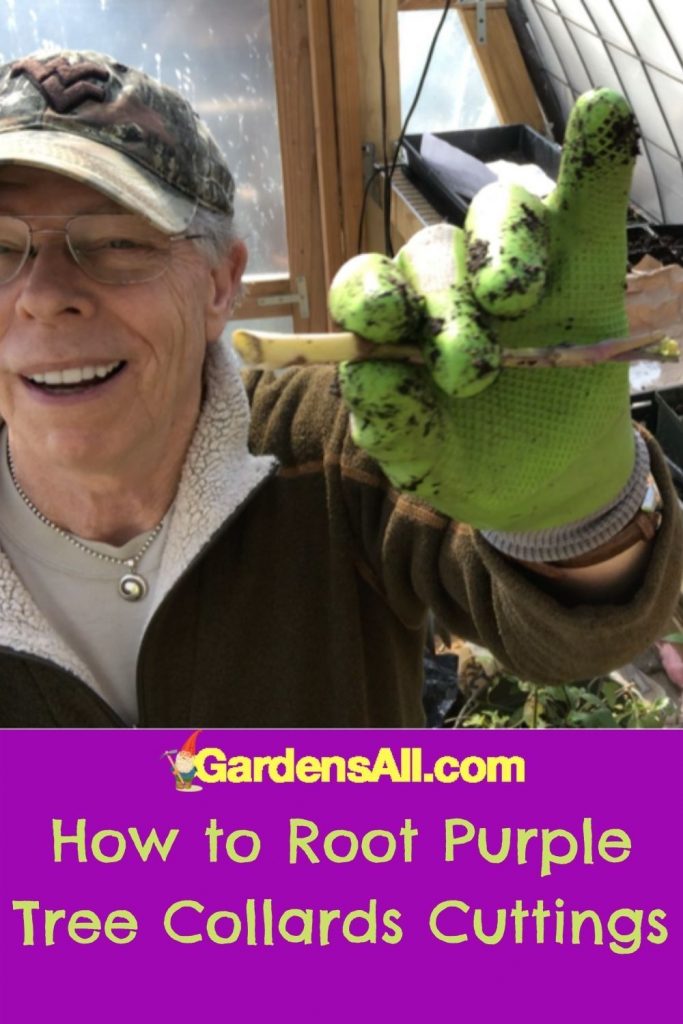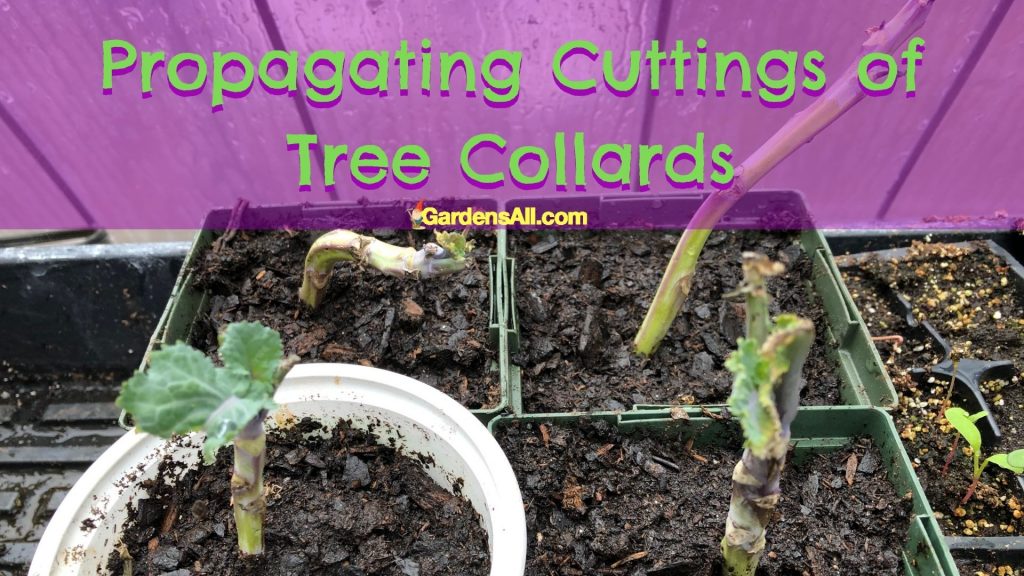Tree Collards Are a Perennial Longevity Plant
We’re really getting into growing perennial vegetables, and more recently we’re growing tree collards in containers and also in raised garden beds. We started with purple tree collards and expanded into green tree collards as well.
Standing tall among their fellow perennial vegetables, tree collards are the most prolific and longest lasting member of the brassicas.
Common Names for Tree Collards
- Purple Collards
- Tree Kale
- Walking Stick Kale
Scientific Name for Tree Collards
- Brassica oleracea var. Acephala
Brassica is latin for cabbage (Brassica oleracea capitata), which is in the mustard family.
Tree Collards Grow Zones
You’ll find mixed information on tree collard grow zones. The reason for this may be — in part — due to different strains of tree collards.
We originally got our cold-hardy purple tree collards from Oikos Tree Crops owned by horticulturist, Ken Asmus in Michigan. His cold hardy strains bred from seeds could withstand Michigan winters.
Unfortunately, Ken has since closed his nursery after 40 years, so you can’t currently buy his cold-hard strain of tree collards. However Ken does plan to continue growing and developing new strains as part of his lifelong work on his farm, with more options for the public over time.
In the meantime, the same type of hardy tree collards has been made available for order by the folks at Project Tree Collard.
Most tree collards do best in growing zones 7-10.
How Many Years Do Tree Collards Live?
A perennial leafy vegetable, tree collards live an average of eight years.
You’ll find different numbers on longevity spinach growing zones and lifespan online. When dealing with lesser known plants and different strains of plants growing in various climates, and growing conditions the numbers ranging between 5 and 15 years.
Tree collards — Brassica oleracea var. Acephala — are the most prolific and longest lasting member of the brassicas, at 10 years on average.
What Do Tree Collards Taste Like?
Tree collards offer gardeners an easy to grow vegetable with luscious tasting green or purple leaves that mimic the flavor of kale. Many gardeners say they prefer the taste of the Purple Tree Collards over the green type, and they also add additional color interest in the garden, so we’re starting with growing purple tree collards.
The amazing plants can grow up to 6 feet tall, and with proper support, even taller with a tree-mendous spread of 6 to 8 feet. Tree collard plants can flourish for as many as 8-10 years! That’s a lot of healthy leaf production for year round food source. Brassica oleracea var. Acephala is a wonderful addition to the vegetable garden or edible landscape or foodscape.
Tree collards taste like a cross between kale, chard and collards.
Challenges Growing Tree Collards
While tree collards are often touted as an easy perennial vegetable to grow, there are definitely challenges. They’re not fussy growers when it comes to soil and sun and they tend to grow well in sun or partial shade.
So given all these positive attributes of longevity, high nutrition and easy growing in varied light and soil, what are some of the problems in growing green and purple tree collards? What’s the catch and why aren’t more people growing them?
Actually there are a few. While Brassica vegetables are often touted as hardy, that’s not the case with these tall plants that originated from the balmy climes of North Africa.
Moderately Cold Hardy to Above 20°F / 6.67°C
The main vulnerability of growing tree collards is plant hardiness as they cannot tolerate winter temperatures below 20°F / 6.67℃. The perennial plants need a protected spot even in USDA Zone 8, where microclimates maintain the coldest temps above the 20°F mark.
A nursery grower in Michigan has been hybridizing Purple Tree Collards toward enhanced hardiness. Results have produced plants that have survived -17°F temperatures in an unheated poly-house. According to Oikos Tree Crops, these extra hardy Purple Tree Collard leaves taste just as delicious as the original tender type.
However, as indicated earlier in this article, Ken Asmus isn’t currently selling them from his nursery in Michigan.
Tree Collards Pest and Disease Issues
Unfortunately, these “walking stick kale” plants are not pest resistant. While we haven’t had issues with disease, we have had three out of five plants destroyed by pests that commonly afflict cabbage and other brassicas, such as cabbage worms and slugs.
We Lost 60% of our Tree Collards to These Pests
- Slugs
- Cabbage worms
- Voles
To help get rid of garden slugs we used Sluggo Plus. For the cabbage worms we applied BT (bacillus thuringiensis) or Dipel, which you can buy from your local hardware or home store, and also on Amazon. We have some tips to get rid of voles and moles, but it’s a harder battle.
Propagating Purple Tree Collards
Purple Tree Collards are difficult to propagate from seed, so growing tree collards by rooting cuttings from a parent plant is much better. Apparently, this is the way most Purple Tree Collards are passed along from grower to grower.
We ordered Purple Tree Collards cuttings from Healthy Harvesters via Etsy. 8 inch healthy cuttings were pruned at the bottom with a sharp knife, the bottom section dipped in .2 percent IBA hormone powder, and grown in preferred mixture of potted medium. We use Black Gold organic potting soil.
Warming mats are useful for keeping plant cuttings at an optimum temperature range of 60-70°.

Growing Tree Collards From Cuttings

Planting Tree Collards Video
Cultivating Purple Tree Collards
Like many other brassicas, tree collards do well in full sun and dappled shade, in rich (organic) soil with only slight acidity, and consistent irrigation. Tree collards grow tall, and If left unstaked, will tumble and sprawl so staking and pruning are necessary.
Tree Collards meet the general definition of perennial food plants in warmer climes and as “tender” perennials that can be nurtured and protected during the winters in colder zones. Our Longevity Spinach (Gynura procumbens) are tender perennials currently snowbirding in our green house.
Tree Collards Size
- 5-10 feet tall
- 5-10 feet wide
Can grow to 4-6′ in one season; can be pruned into bush form or staked to grow tall.
Growing Tree Collards in Containers
Individual tree collards grow well in containers, which offers the advantage of taking them indoors for the winter. So if you’re growing tree collards in a colder climate, you might want to start out with them in pots.
Another tactic would be to treat them as an annual crop. You can take cuttings to root indoors and set the new plants back out in spring.
We’re started growing tree collards in containers so that we can move them outside in spring through fall. Come winter temps below freezing, we’ll bring them indoors to our sunroom or else into our cattle panel greenhouse. We’ll probably end up with a large pot in both places, that way we can easily harvest leaves for daily use to add into most meals.
Once we get our first-year Purple Tree Collards going as container plants, they’ll be taken inside the greenhouse for the winter and set out the next spring. If they’re thriving inside, we’ll definitely continue harvesting leaves from them throughout the winter. If they grow slow or dormant, we’ll just pluck a leaf a day like chewable vitamins like we do with our longevity spinach. 😎🍃
Staking Tree Collards in Containers
As tree collards grow taller, they typically need staking. You could grow your tree collards in planters with a built in climbing trellis, or against a wall with a trellis. Growing vertically works best in locations with limited sunlit space.

Pruning Tree Collards
When growing tree collards in containers it’s best to prune them from getting so tall, in which case you may not need to stake them. Pruning the height should help them bush out and become fuller rather than taller and leggy.
You can also prune your tree collards into the shape you’d prefer and dependent on whether you have more vertical or horizontal space to work with. When growing them taller, you can use tomato cages for staking in pots, or a teepee stakes made from bamboo or wood.
Where to Buy Tree Collard Plants
- Project Tree Collard
- Etsy
- Amazon
- Oikos Tree Crops – nursery is closed by may still have helpful information
We’re also testing the Purple Tree Collard hybrids from Oikos Tree Crops. Time will tell how these hybrids perform in our Zone 7A gardens. So we’ll be back here with updates.
UPDATE: So far our purple collards are holding up to zone 7a weather. However, our greatest challenge has been pests, so we’re stepping up our treatments accordingly.
Growing Perennial Vegetables
We’re eagerly increasing the number of perennial vegetables we’re growing. It just makes so much sense toward food security and return on investment. A good book we’re enjoying is: Perennial Vegetables by Eric Toensmeier, which includes a section on tree collards.
Are any of you growing tree collards (green or purple)? We’d be glad to hear about your experience, and see any photos you care to share.
If you’re interested in tree collards you will likely also be interested in longevity spinach, Gynura procumbens.

How to Propagate & Grow Tree Collards
G. Coleman Alderson is an entrepreneur, land manager, investor, gardener, and author of the novel, Mountain Whispers: Days Without Sun. Coleman holds an MS from Penn State where his thesis centered on horticulture, park planning, design, and maintenance. He’s a member of the Phi Kappa Phi Honor Society and a licensed building contractor for 27 years. “But nothing surpasses my 40 years of lessons from the field and garden. And in the garden, as in life, it’s always interesting because those lessons never end!” Coleman Alderson

